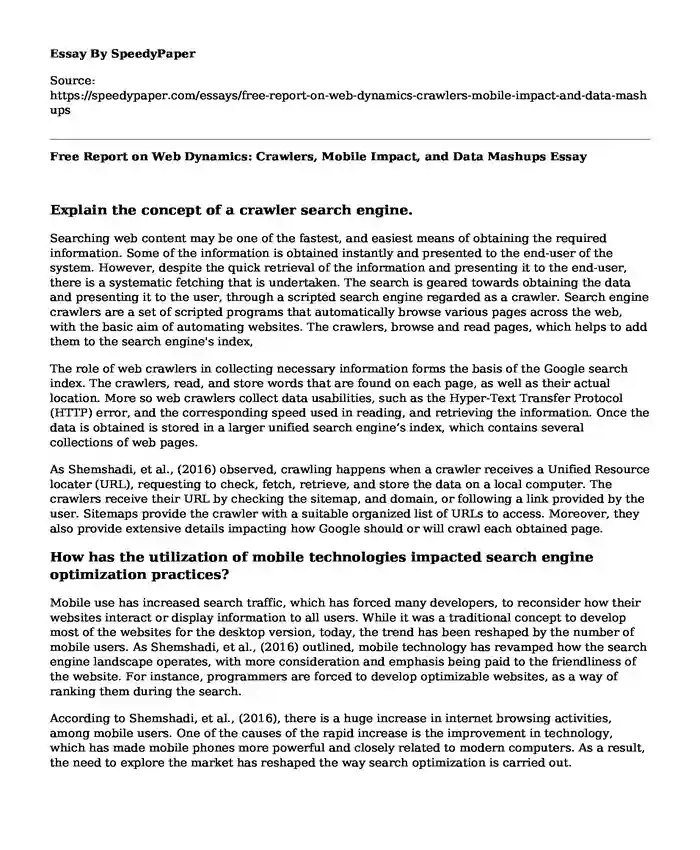
| Type of paper: | Essay |
| Categories: | Computer science Technology Development |
| Pages: | 3 |
| Wordcount: | 668 words |
Explain the concept of a crawler search engine.
Searching web content may be one of the fastest, and easiest means of obtaining the required information. Some of the information is obtained instantly and presented to the end-user of the system. However, despite the quick retrieval of the information and presenting it to the end-user, there is a systematic fetching that is undertaken. The search is geared towards obtaining the data and presenting it to the user, through a scripted search engine regarded as a crawler. Search engine crawlers are a set of scripted programs that automatically browse various pages across the web, with the basic aim of automating websites. The crawlers, browse and read pages, which helps to add them to the search engine's index,
The role of web crawlers in collecting necessary information forms the basis of the Google search index. The crawlers, read, and store words that are found on each page, as well as their actual location. More so web crawlers collect data usabilities, such as the Hyper-Text Transfer Protocol (HTTP) error, and the corresponding speed used in reading, and retrieving the information. Once the data is obtained is stored in a larger unified search engine’s index, which contains several collections of web pages.
As Shemshadi, et al., (2016) observed, crawling happens when a crawler receives a Unified Resource locater (URL), requesting to check, fetch, retrieve, and store the data on a local computer. The crawlers receive their URL by checking the sitemap, and domain, or following a link provided by the user. Sitemaps provide the crawler with a suitable organized list of URLs to access. Moreover, they also provide extensive details impacting how Google should or will crawl each obtained page.
How has the utilization of mobile technologies impacted search engine optimization practices?
Mobile use has increased search traffic, which has forced many developers, to reconsider how their websites interact or display information to all users. While it was a traditional concept to develop most of the websites for the desktop version, today, the trend has been reshaped by the number of mobile users. As Shemshadi, et al., (2016) outlined, mobile technology has revamped how the search engine landscape operates, with more consideration and emphasis being paid to the friendliness of the website. For instance, programmers are forced to develop optimizable websites, as a way of ranking them during the search.
According to Shemshadi, et al., (2016), there is a huge increase in internet browsing activities, among mobile users. One of the causes of the rapid increase is the improvement in technology, which has made mobile phones more powerful and closely related to modern computers. As a result, the need to explore the market has reshaped the way search optimization is carried out.
Describe how mashups create new benefits and functionality from existing data or information.
As Ciortea, et al., (2017) outlined, mashups offer lightweight web services, through merging, transforming, as well as mixing capabilities of new, and existing information, in the quest of delivering useful new functionalities to the end-users.
Data mashup is becoming an essential tool for many businesses across the globe. Data mashups offer an opportunity to small businesses, or vendors to create applications that allow the unification of disparate data sources to be improved without heavily relying on heavy IT and data warehousing. Data mashups play a vital role in empowering analysts, allowing them to shift through reports with underlying gathered data. Mashups provide prototyping, and rapid application assembly, with faster scalability, access control, security, and policy. As a result, this helps reduce development time and cost.
References
Ciortea, A., Boissier, O., & Ricci, A. (2017, October). Beyond physical mashups: Autonomous systems for the Web of Things. In Proceedings of the Eighth International Workshop on the Web of Things (pp. 16-20). doi.org/10.1145/3199919.3199924
Shemshadi, A., Sheng, Q. Z., & Qin, Y. (2016, July). ThingSeek: A crawler and search engine for the Internet of Things. In Proceedings of the 39th International ACM SIGIR conference on Research and Development in Information Retrieval (pp. 1149-1152). doi.org/10.1145/2911451.2911471
Cite this page
Free Report on Web Dynamics: Crawlers, Mobile Impact, and Data Mashups. (2024, Jan 05). Retrieved from https://speedypaper.net/essays/free-report-on-web-dynamics-crawlers-mobile-impact-and-data-mashups
Request Removal
If you are the original author of this essay and no longer wish to have it published on the SpeedyPaper website, please click below to request its removal:
- Essay Sample on Computer Based Medical Records
- Essay Example: Human Development Report
- Algorithm Analysis - Essay Example in Computer Science
- Essay Sample on Electronic Health System Review
- Essay Sample on Factors That Influence Child Development
- Analysis Essay Example on Consumer Health Information Website
- IT Certifications - Essay Sample
Popular categories




